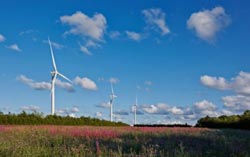Storage Heaters as Buffers for Wind Power

<br>
In the RWE Wind Heating project, the two companies have worked together with tekmar Regelsysteme GmbH to equip the storage heating systems in two neighborhoods with smart control devices.
The storage heaters were programmed to charge their heat stores whenever there was too much sunshine or the wind was blowing. The test phase begun in 2011 has shown that the concept is very effective.
State-of-the-art storage heating systems that are appropriately set up for the buildings they heat are energy-efficient, inexpensive, and simple. The units charge the heaters at night using inexpensive power, and release the heat again during the day. However, instead of storing off-peak power at night, the heaters could also act as a temporary store for surplus wind and solar power.
According to energy experts, all of the storage heaters in Germany could potentially store 14,000 gigawatt-hours (GWh) of power each year. By contrast, Germany's pumped-storage electrical power stations have a combined storage capacity of around 40 GWh per year.
An important precondition for the use of storage heaters as buffers for green electricity is the availability of a smart control device for the charging process. This is made possible by the Siemens software DEMS (Decentralized Energy Management System), which generates consumption forecasts based on existing user data. The software then uses these forecasts as well as information about the weather, the current electricity prices, and the amount of storage capacity available to decide when a heat store should be charged. The command is transmitted to the control unit via wireless.
The concept has been tested in residential areas containing a variety of storage heating systems: underfloor heating, separate furnaces, and block storage units. What the residents particularly like about the systems is that they heat the apartments evenly.
Whereas a wind-powered heating system is continuously recharged during the day, conventional storage heaters are very warm in the mornings and cool off toward evening. The task now is to make the system attractive for all users of storage heaters by finding ways in which they can benefit from inexpensive wind and solar power prices.
Media Contact
More Information:
http://www.siemens.com/innovationnewsAll latest news from the category: Power and Electrical Engineering
This topic covers issues related to energy generation, conversion, transportation and consumption and how the industry is addressing the challenge of energy efficiency in general.
innovations-report provides in-depth and informative reports and articles on subjects ranging from wind energy, fuel cell technology, solar energy, geothermal energy, petroleum, gas, nuclear engineering, alternative energy and energy efficiency to fusion, hydrogen and superconductor technologies.
Newest articles

Silicon Carbide Innovation Alliance to drive industrial-scale semiconductor work
Known for its ability to withstand extreme environments and high voltages, silicon carbide (SiC) is a semiconducting material made up of silicon and carbon atoms arranged into crystals that is…

New SPECT/CT technique shows impressive biomarker identification
…offers increased access for prostate cancer patients. A novel SPECT/CT acquisition method can accurately detect radiopharmaceutical biodistribution in a convenient manner for prostate cancer patients, opening the door for more…

How 3D printers can give robots a soft touch
Soft skin coverings and touch sensors have emerged as a promising feature for robots that are both safer and more intuitive for human interaction, but they are expensive and difficult…





















